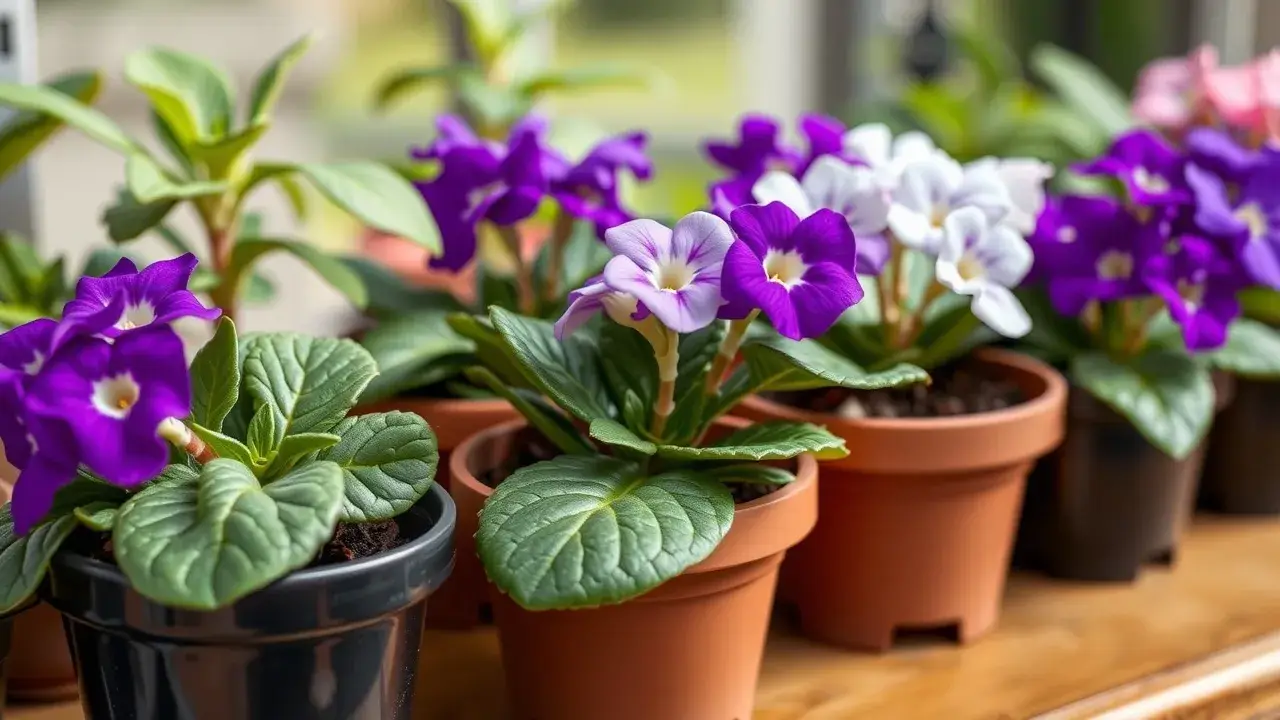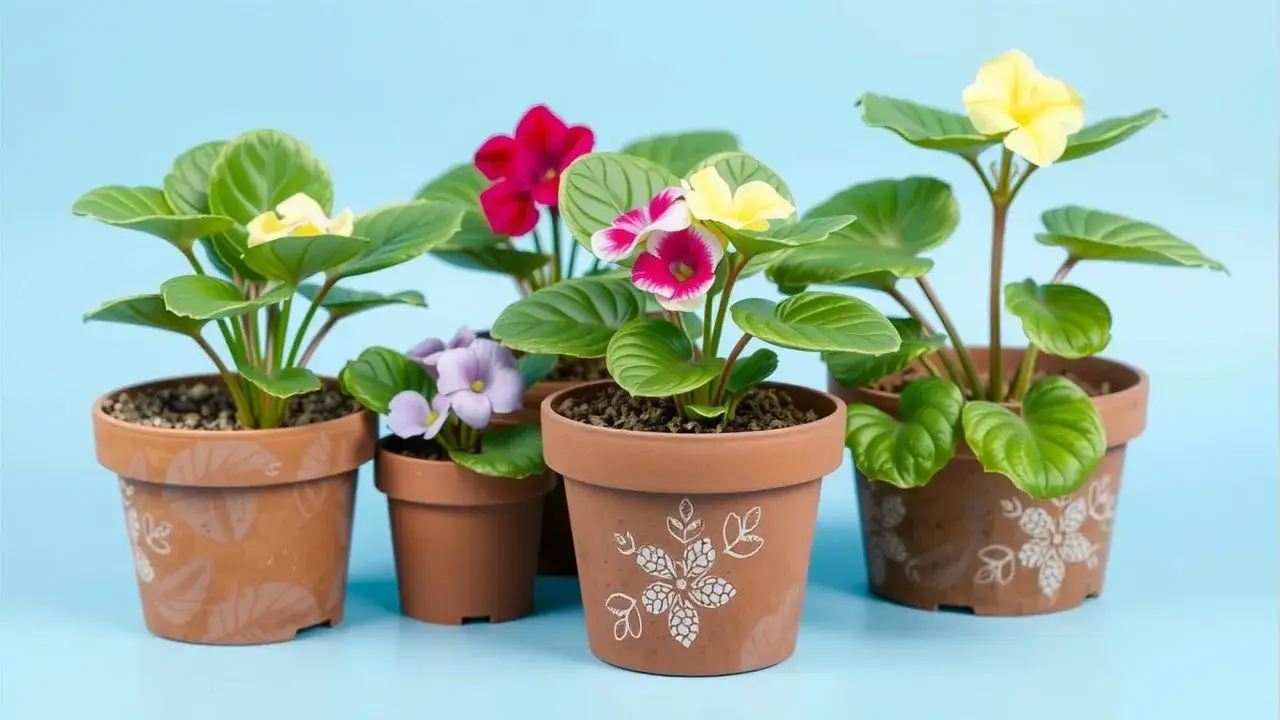Types of pots for African violets matter greatly for their health. Choose the right size, material (like plastic or clay), and drainage to keep your African violets thriving.
What Are African Violets?

African violets are cool houseplants that many people love. They are known for their pretty flowers and soft leaves. These plants come from a family called Gesneriaceae. They do really well indoors, which makes them perfect for home gardens. With the right care, African violets can bloom many times a year. This brings bright colors into your home! When potting African violets, it’s super important to choose the right pot. The right pot helps the plant grow strong and healthy.
Why Does Pot Choice Matter for African Violets?
Choosing the right pot is key for keeping your African violets happy and healthy. Different pots can help or hurt the plant’s roots and growth.
Types of Pots:
- Plastic Pots: These are light and cheap. They hold moisture but might not let air reach the roots well.
- Ceramic Pots: These look nice and keep moisture, but they can be heavy and break easily.
- Terracotta Pots: These pots let water drain out well because they’re porous, but they dry out quickly, so you need to water more often.
Impact on Root Health: Strong roots lead to beautiful flowers in African violets. If you pick a bad pot type, it could mean too much water or not enough drainage, which can cause root rot.
Common Problems Caused by Incorrect Pots:
- Too much water might drown roots if there aren’t enough drainage holes.
- Not enough water can happen if terracotta dries out too fast, stopping growth.
- Roots might get crowded in small pots, which limits how they take in nutrients.
Drainage Holes Importance: Good drainage stops water from sitting at the bottom of the pot. This is super important since too much water can lead to rot for these delicate plants.
When you choose pots for your African violets, remember it’s not just about how they look. It’s also about how they affect water management and root health in each environment where your plant lives!
Types of Pots Suitable for African Violets
Clay Pots for African Violets
Clay pots are a top choice for many people who grow African violets. They include terracotta and unglazed options. These pots are made from materials that let air pass through. This helps the roots breathe and lets water evaporate quickly. Because of this, clay pots help avoid overwatering. The soil dries faster, which is good for your plants.
One big plus of clay pots is their great drainage. They keep extra moisture away from the roots. This reduces the risk of root rot, which can be a real problem for African violets. But there’s a downside too. Clay pots lose moisture quickly. This means you’ll have to water your plants more often compared to plastic or self-watering pots. Also, minerals can leak into the soil over time, which might not be good for plant health.
Experienced growers like using clay pots in dry places where good airflow is important for healthy growth.
Plastic Pots for African Violets
Plastic pots are another popular option because they are light and affordable. Unlike clay pots, these containers do not let air through and hold onto moisture really well. This makes them a great choice for beginners who may forget to water their plants on time.
The best part about plastic pots is that they cut down how often you need to water your plants since they keep moisture longer than other types of containers. However, a big downside is that if the drainage holes aren’t designed properly, it can lead to overwatering. When this happens, humidity can build up around the roots, which isn’t good for your African violets.
These pots are perfect for those just starting out or living in humid areas where keeping moisture isn’t a problem.
Self-Watering Pots for African Violets
Self-watering pots are super handy! They have systems that keep water available for your plants at all times through something called wicking. This means the African violets can drink when they need it without you having to check on them all the time.
A huge benefit of self-watering pots is they help avoid underwatering problems—ideal for busy people who might forget to water regularly. They provide steady moisture without putting too much stress on both the plant and you!
But remember, there could be some issues if you don’t watch them closely. If too much water gets stuck in there, it might cause root rot even though they seem easy to use!
Choosing the right pot matters when taking care of African violets! Each type has its own perks and downsides that suit different needs and situations.
Choosing the Right Size Pot for African Violets
Importance of Pot Size
Choosing the right pot size for your African violets matters a lot. The pot size helps how the roots grow. If you pick a pot that’s too small, called under-potting, the roots can get stuck and tangled up. This is not good for the plant, and it can stop growing properly.
If the pot is too big, known as over-potting, that can cause trouble too. Extra soil in a large pot holds too much water. This can lead to root rot because there isn’t enough drainage. So, finding a good size pot is key to keeping your African violets healthy.
Determining Ideal Pot Size
To find the best pot size for your African violet, look at its current root ball. You want a new pot that is just a bit bigger—about 1-2 inches wider in diameter works well.
Here are some steps to help you choose:
- Measure: Check how wide the plant’s current container is.
- Select: Pick pots meant for small plants or specifically made for African violets.
- Check Depth: Make sure it’s deep enough but not too deep for good drainage.
Using pictures or diagrams showing different pot sizes can make it easier when shopping online or at stores.
Repotting
Repotting is important as your African violets grow. Here’s when and how to do it:
- When to Repot: Look for signs like roots poking out of drainage holes or slow growth even with care.
- How to Repot:
- Carefully take the plant out of its old pot while holding its leaves.
- Shake off any extra soil from around the roots.
- Place it in its new pot filled with fresh soil made for African violets.
- Water it lightly after repotting but don’t soak it right away.
Following these steps will help keep your plants happy and reduce stress during their move! By learning about pot sizes and repotting, you can help your African violets thrive!
The Role of Drainage in Healthy Growth
Importance of Drainage Holes
Drainage holes are super important for keeping African violets healthy. These little holes let extra water escape, so the roots don’t sit in water. If they do, the roots can rot, and that’s not good! When you pick pots for your African violets, make sure they have drainage holes at the bottom. This helps to keep the soil from getting too soggy.
Also, think about potting techniques. When you repot your African violet, don’t bury the crown too deep. Keep it just above the soil line. This allows air to reach the roots and helps with moisture balance.
Using Drainage Saucers Effectively
Using drainage saucers is another key part of caring for African violets. These saucers catch any water that drips out of the pot. However, you need to check them often! If water sits in the saucer for too long, it can cause root rot.
To avoid this, empty any standing water from the saucer a few hours after watering your plant. This keeps the roots safe and happy by allowing them to breathe instead of sitting in stale water.
Other Drainage Considerations
Choosing well-draining soil is just as important as picking the right pot for your African violets. Look for a potting mix made for these plants or one labeled as “well-draining.” Good mixes often have stuff like peat moss or perlite. These ingredients help air get to the roots and stop soil from packing down too much.
You might also want to try moisture control pots. They can help manage how much water stays in the pot while still letting some moisture evaporate. Just remember that there still needs to be enough drainage so your plants don’t get overwatered.
Understanding these drainage details is super important for keeping your African violets vibrant and happy!
Choosing the Right Potting Mix

Ideal Potting Mix Characteristics
When picking a potting mix for your African violets, you want one that drains well and keeps some moisture. A good African violet potting mix lets water out but also holds enough for the roots. This helps stop root rot, which is bad for your plants. Look for mixes labeled for African violets or ones made for houseplants with similar needs.
Recommended Mix Ingredients:To make a great potting mix, you need a few key ingredients:
- Peat Moss: This keeps the soil moist and airy. It makes the soil light, so roots can breathe.
- Perlite: This helps with drainage. It stops soil from packing down and lets air get to the roots.
- Vermiculite: Like perlite, vermiculite improves drainage but can also hold some nutrients and water without making things too wet.
- Potting Soil for African Violets: Many store blends include these ingredients plus others made just for healthy African violets.
Mixing these together creates a space where your plants can grow well without too much or too little water.
Avoiding Issues:Don’t use fertilizer in your first potting mix when planting African violets, especially in self-watering pots. Fertilizers can build up because they don’t drain out like other pots. Too much fertilizer can create salt buildup in the soil, which hurts roots and can cause leaf problems. Starting with only good potting materials helps your plants settle in before adding any fertilizer later if needed.
Material Comparison: A Detailed Overview
Porosity
Porosity is really important for your African violets. Unglazed terracotta pots are very porous. They help air move in and let water drain out, which stops root rot. If you use plastic or glazed ceramic pots, choose a porous potting mix for African violets. This will help keep the roots healthy and not too wet.
Watering Frequency
Watering frequency matters a lot when growing African violets. These plants like bottom watering. This way, they can drink from below without wetting their leaves. Wet leaves can get spots or even rot! Check the top of the soil; if it feels dry about an inch down, it’s time to water again.
Moisture Retention
The right potting mix helps with moisture retention for your African violets. Look for mixes called “moisture-retentive.” They often have peat moss or coconut coir, which keep the soil wet but also let it drain well. Using these mixes with the right pots helps keep your plants happy and hydrated without drowning them.
Advantages and Disadvantages
Here’s a quick list of the pros and cons of different pot types:
- Clay vs Plastic: Clay pots let air through but dry out quickly compared to plastic ones.
- Terracotta Benefits: Terracotta breathes well but needs more watering since it dries out fast.
- Self-Watering Drawbacks: Self-watering pots keep moisture balanced but can cause overwatering if you don’t check them.
Understanding these things helps you pick the best container for your garden style.
Best Use Cases
Choosing the right pot size is key for healthy African violets. Usually, a 4-6 inch pot works best for most mature plants. Smaller pots are better for young plants until they grow roots strong enough. If you’re planting indoors, light plastic pots are great where stability isn’t a worry. For outside plants, pretty ceramic ones can make your garden look nice without being too heavy.
Knowing how different materials work with African violets will help both beginners and seasoned plant lovers create a thriving home for their green friends!
Troubleshooting Common Potting Problems
Overwatering & Underwatering
Overwatering and underwatering are big problems for African violets. It’s important to spot the signs of each so your plants stay happy.
Symptoms of Overwatering:
When you give an African violet too much water, the leaves turn yellow. They might feel soft or mushy. The plant can also droop, even if the soil is wet. You may see dark spots on leaves or smell something bad from the pot—this means root rot might be starting.
Solutions for Overwatering:
If you think your plant is overwatered, check for blocked drainage holes. Let the soil dry out completely before you water again. You can also repot your plant in fresh soil that drains well to help it recover.
Symptoms of Underwatering:
If your plant doesn’t get enough water, the leaves curl up or wilt. They feel dry and may have brown edges that are crispy from lack of moisture.
Solutions for Underwatering:
To fix this, give your African violet a good drink until water comes out of the bottom of its pot. From now on, keep the soil moist but not soggy.
Root Rot
Root rot can be a serious issue for African violets. This happens mostly due to too much water and not enough drainage. Healthy roots should be white and firm. If they’re brownish-black and mushy, you’ve got a problem.
Causes of Root Rot:
Root rot usually happens when water sits around the roots without airflow or drainage. This problem gets worse if you use soil that packs down too much and holds too much water.
Prevention Tips:
To stop root rot:
- Use pots with good drainage holes.
- Pick a lightweight mix made just for African violets.
- Water based on how dry the soil feels instead of on a set schedule.
Following these steps will help keep your plants healthy and free from decay.
Other Problems
Besides overwatering and root rot, there are other issues like mold growth in pots. Mold often comes from high humidity or not enough air around your plants. You’ll see fuzzy patches on topsoil when this happens, which could mean there’s poor ventilation or damp materials used in potting.
To tackle mold growth effectively:
- Carefully remove any visible mold with clean tools.
- Change your watering habits to let the surface dry between watering.
- Improve airflow by spacing out your plants if they’re crowded indoors or outside.
By paying attention to these problems and caring for your African violets properly, you can enjoy beautiful blooms without facing common potting challenges!
FAQs About Pots for African Violets
What are the best materials for pots?
The best materials include plastic, ceramic, and terracotta. Each has unique benefits for your African violets.
How do I choose the right size pot?
Select a pot that is 1-2 inches wider than the current one. This size supports root growth without water issues.
Are there special pots for African violets?
Yes, you can find specific African violet planters that ensure proper drainage and moisture control.
What is the ideal pot size for small African violets?
Use 4-inch pots for small or young plants. They provide enough room without causing overwatering.
Should I use self-watering pots?
Self-watering pots work well if you watch for too much moisture. They help keep soil consistently moist.
Additional Key Points
Choosing the Right Potting Mix
- Use a well-draining soil mix with peat moss and perlite.
- Avoid heavy soils that retain too much moisture.
Ideal Drainage Features
- Look for pots with multiple drainage holes.
- Ensure proper airflow around roots to prevent rot.
Pot-Bound African Violets
- Repot when roots circle inside the pot.
- Choose a slightly larger pot to allow growth.
Lightweight Pot Options
- Consider plastic or glazed containers for easy handling.
- Lightweight pots help manage humidity levels effectively.
Moisture Control Techniques
- Bottom watering helps maintain ideal soil moisture.
- Check topsoil; water when it feels dry about an inch down.
These tips will assist you in choosing the right type of pot for your African violets. Happy gardening!
Related Topics
- Types of African Violet Pots
- Types of Pots for African Violets
- Types of Potting Mix for African Violets
- Types of Potting Problems for African Violets
- Types of Watering Techniques for African Violets
- Types of African Violet Growth Stages
- Types of African Violet Soil
- Types of Potting Mix Ingredients



Types of Pot For African Violets: Size, Material & Drainage Guide